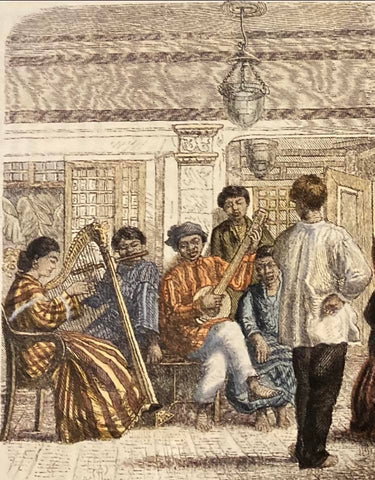
The first image above is the full illustration called Gessellschaftliche Vergnügungen in Manila [Social Entertainment in Manila] (1864), from Gustav Spiess, showing a man and woman dancing in the center of the room, a band playing instruments to the left, and people standing and sitting in the background and at a table to the right.
Spiess is the Merchant Delegate of Saxony. He published this illustration with his account of the Prussian Expedition of East Asia, which took place from 1859 to 1861. Our descriptions of this expedition and Spiess are in our previous installment 15.1.

The second image above is a closer look at the left side of the piece showing, from left to right, a woman playing a harp, a man playing a flute, a man playing a guitar, a standing male spectator, a sitting female spectator and the male dancer. All the women wear baro’t saya (blouse and skirt) with tapis (overskirt) and pañuelo (shawl). All the men wear Barong Tagalog with pants.

The third image above is a closer look at the right side of this piece. At the far left is the female dancer in baro’t saya with tapis and pañuelo. At the center sitting at the edge of the table, watching the dancers while enjoying a drink, is the municipal leader that is a member of the principalia class, an elite class of Filipino men working with and on behalf of the Spanish colonial government. He wears a Barong Tagalog with jacket over it, pants, and he carries a staff in his right hand, which is how many principales dressed as was permitted by Spanish edict. Also seated at the table is a clergyman with his back to us and a western military man to the far right.

The fourth image above is the original illustration that Spiess copied from. It is an untitled ballroom dancing piece by English artist Charles W. Andrews published approximately in 1860-1861. Compared to this piece, Spiess’ drawing is practically identical with the same fifteen characters. We cover Andrews’ illustration in Addendum Part 11.7.

The fifth image above is another illustration that copied from Andrews’ ballroom dancing piece - Fète à Santa Cruz de Nano [Party at Santa Cruz de Nano], published in 1886, from French naturalist, explorer, author and publisher Antoine-Alfred Marché. Our descriptions of Marché and his ballroom illustration are in Addendum Part 10.20.
